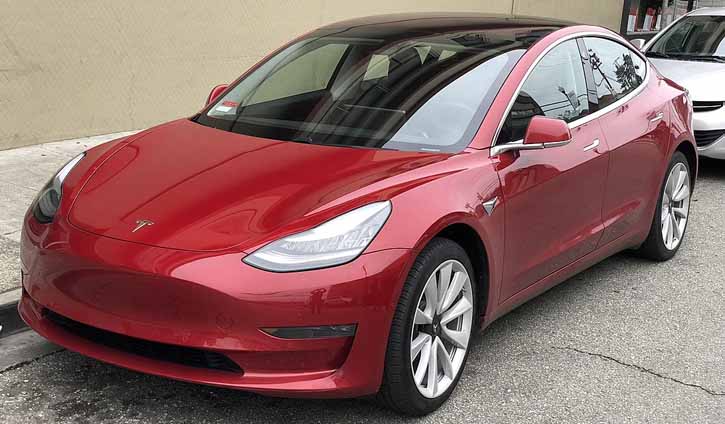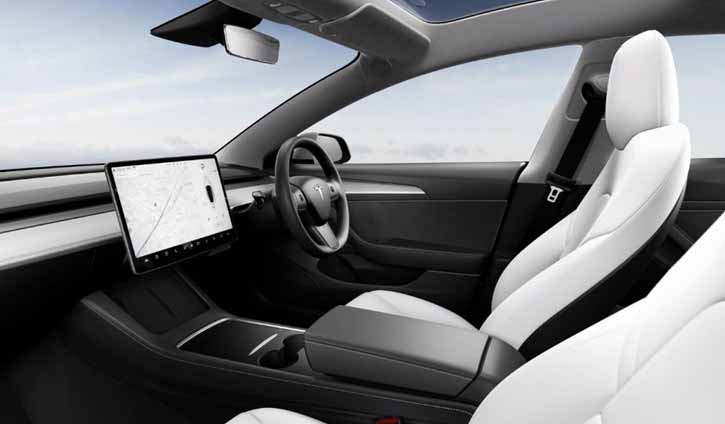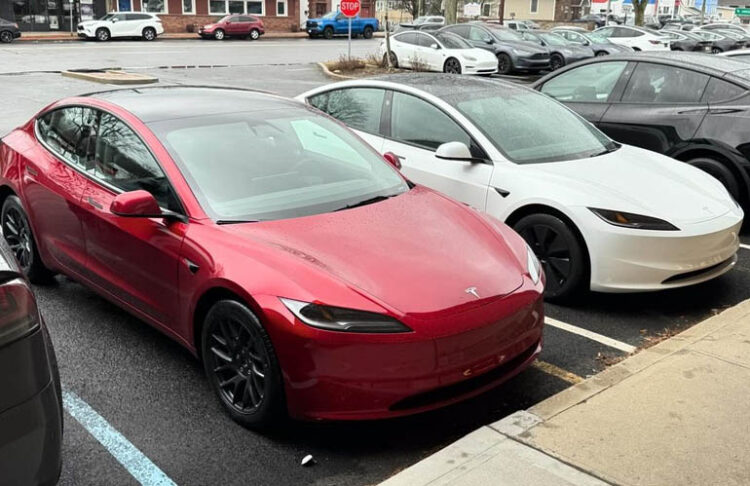Driving a Tesla for the first time can be daunting, so we’ve explained everything you need to know about operating a Model 3. So you’re getting in a Tesla for the first time, or maybe you’re just curious about how they work. The experience can be somewhat intimidating.
Table of Contents
How do you turn it on? Why isn’t it making any noise? Does it drive itself? What is one-pedal driving? Tesla, the EV (electric vehicle) frontrunner for the past decade, has some of the most technologically advanced EVs on the market. The company is currently at the forefront of autonomous tech with its Autopilot and Full Self Driving features, and the car now has the capability to slow itself down when approaching stop signs and red lights.
Tesla’s are constantly evolving through over-the-air updates—yes, like an iPhone—and the majority of the car’s controls, including the trunk, glovebox, windshield wipers, and climate control, are accessed on a 15-inch touchscreen mounted on the centre of the dashboard. There are a lot of unusual interactions and controls. It’s a bit daunting if you’re getting behind the wheel of a Tesla for the first time, but don’t worry; we’ve answered all your questions.
Getting Started
Our Tesla Model 3 has three keys: a Tesla key card; a key fob, which is a ₦54,075.00 accessory; and your phone, which you can set up through the Tesla mobile app to work as a key. To unlock the car with the key card, swipe the card on the B-pillar, and the door will unlock or lock. With the key fob or phone as a key, simply approach the car, push in the right side of the door handle, and pull the door open. The car will lock automatically once the phone or key fob is about five feet away from the car. You can also unlock or lock the car remotely via the Tesla mobile app or simply push on the roof of the car-shaped Tesla key fob.
Also Read: Can I Buy A Tesla In Nigeria? Is It Going To Work?
There’s No Ignition
You don’t really turn on the car, either. Simply depress the brake pedal, push the right stalk on the steering column—it goes up for reverse and down for drive—and you’re off. To engage neutral, gently push up to the first stopping point on the right stalk for about two seconds. When you’re done driving, put the car in a park by pushing the button on the side of the right stalk.
Making Adjustments
To adjust the steering wheel and mirrors, touch the front-facing car icon at the bottom left of the central touchscreen. This will bring up all of the vehicle’s settings menus. Make sure you’re under Quick Controls. This will allow you to adjust the steering wheel and mirrors via the two buttons and spin wheels on the steering wheel. Here, you can also turn the lights on or off, fold the mirrors inward, lock the windows, and adjust the screen’s brightness. Adjustments, including the driver’s seating position, can be saved on up to 10 driver profiles that can be chosen at the top right of the screen.
Driving, Cruise Control, and Autopilot
Driving an electric car isn’t that much different from driving a gasoline-powered car—other than that they make almost no noise at all. As we said earlier, you never really start the car. You just put it in gear and silently creep away. Fair warning: the instant torque during hard acceleration might frighten you at first, but trust us, it can get a bit addicting. The reverse is different, though, because the car emits a high-pitched humming sound when in reverse—this definitely gets a lot of raised eyebrows from onlookers.
The Driving Graphic
On the left side of the Model 3’s centre-mounted 15-inch touchscreen, there is a driving graphic that displays your car, lanes in the road, bike lanes, railroad crossings, road arrows, stop signs, stoplights, pedestrians, and other cars (it even differentiates among cars, trucks, and SUVs). There isn’t a typical gauge cluster in front of the Model 3’s steering wheel as there is in most gas-powered cars. Instead, the Model 3’s speed is displayed above the driving graphic. That’s also where the blinkers flash.
How to Use Cruise Control
Under the speedometer are the cruise-control speed settings. To engage cruise control, press down once on the right stalk while in the drive. The Model 3 is equipped with adaptive cruise control, meaning cameras on the outside of the car detect its surroundings and decelerate or accelerate to maintain following distances. To adjust the speed, there are + and – symbols next to the speed or you can use the right wheel on the steering wheel to speed up or slow down.
Also Read: Meet New Tesla Superchargers
How to Engage Autopilot
To use the Model 3’s Autopilot, press down on the right stalk twice. You’ll hear a chime, and the lanes on the driving graphic will turn blue, indicating that the car will stay in that lane. Once Autopilot is engaged, the car will continue to slow down and accelerate based on the set cruise control speed and also take gradual turns.
In a car equipped with the Full Self Driving option, Autopilot can change lanes, too. Simply hit the blinker and the car will switch lanes for you. If there’s a vehicle in the way, the exterior cameras will detect it and wait for the way to be clear.
Bring the Car to You Remotely with Summon and Smart Summon
Autopilot and Summon are standard on Model 3s. C/D’s long-term test car has the Full Self Driving option, which includes automatic lane changing and Smart Summon. You have to be within approximately 200 feet of your car to use Smart Summon. Both Summon and Smart Summon work through the Tesla mobile app. Summon will move the car forward or reverse, while Smart Summon can bring your parked car to your location without a driver. In the app, use the crosshair-like icon to show your location, and hold the Summon icon to bring the car to you.
One-Pedal Driving
The Model 3 has full one-pedal driving due to regenerative braking. Simply put, regenerative braking means that when you let off the throttle, the car automatically starts slowing by using the electric motor in reverse, which also serves to send energy back to the battery. If the car’s charge is full, though, regenerative braking will be reduced, and the car will not stop itself. Regenerative braking is most apparent when the car is in a lower state of charge, therefore reserving the battery’s charge.
The 15-Inch Touchscreen
The Tesla Model 3’s interior is very minimalistic, meaning there aren’t many buttons or knobs. There’s just one large 15-inch touchscreen in the middle of the dashboard where the majority of the controls are, as well as two scrollable buttons on each side of the steering wheel. Normal things you expect to see in a car like a radio, air conditioning, and controls to adjust the mirrors or the steering wheel are all controlled on the central touchscreen.

Open the Glovebox via the Touchscreen
Yes, in the Model 3, even the glovebox opens via touchscreen. Hit the car icon at the bottom right of the screen to open up the settings menu, and on the left under the system menus, there is a button to open the glovebox. It closes manually.
How to Use the Climate Controls
The climate-control settings are also integrated in the central touchscreen. Select the fan icon at the bottom of the screen, and the climate control settings pop up. In the Model 3, the air blows out of a vent that sprawls across the entire dash—just above the wood panelling in our long-term test car. Our Model 3 also has heated seats, which can be controlled in this menu, too. We can choose which seat is heated, even the middle back seat, and how much heat comes out in three levels.
Ask Anything with Voice Command
Below the driving graphic, there is a microphone icon that’s used to bring up voice commands. You can also press the right scroll button on the steering wheel to activate voice commands. There will be an activation tone, and then you can speak commands such as “Show me Superchargers,” “Lock the doors,” or “Text Connor.”
Stay Entertained
To help you kill time at charging stations, Netflix, Hulu, Twitch, and YouTube are integrated into the Model 3’s entertainment menu. On the Model 3 they work like any other streaming device, but they can only be used while the car is in park. The entertainment menu is also loaded with games. Our favourite is a Mario Kart-like racing game where the Model 3’s brake pedal and steering wheel are used to control the car in-game. In addition to streaming apps and games, Tesla owners can browse the web directly from the car’s touchscreen. Owners can also log into their Spotify account to stream their music in the car or they can connect a Bluetooth device, listen to the radio, or search for podcasts.
Charging Tesla Model 3 at Home
All Teslas come out of the box with a mobile connector that has a 20-foot cable that can charge the car from different wall outlets at medium to low speeds. The mobile connector kit includes an adapter for standard 120-volt household outlets that will charge the Model 3 and Model S at around three miles of range per hour, and the Model X at around two miles of range per hour. Other adapters for different outlets can be purchased directly through Tesla.
However, the majority of Tesla owners have charging units installed at their homes. Wall connectors can work with almost any home power supply and are purchased from Tesla for ₦180,250.00. Through Tesla’s website, a local electrician who has been trained to install Tesla charging equipment can be found to install the wall connector either indoors or out. Tesla’s own installation services are also available, but only in certain areas. Connected to a wall charger, the Model 3 can charge up to 44 miles of range per hour of charge at an 11.5-kW or 48-amp output.
Customers can also get Tesla’s Powerwall, which starts at ₦2,4 million. It’s essentially a giant battery plugged into the wall. Powerwall gives homeowners the ability to store power produced either by solar panels or during off-peak times to be used later to power their home or charge their Tesla. Like the wall charger and other Tesla accessories, the Powerwall can be ordered directly from the Tesla website.
Tesla Performance
Our long-term Dual Motor Tesla Model 3 Long Range weighed in at 4038 pounds and launched from zero to 60 mph in 4.1 seconds. That acceleration hits hard, due to the instant torque provided by the electric motors, and in the higher-performance Tesla models, there’s even more oomph. The Model 3 Performance can do 60 mph in 3.5 seconds, and when we tested the larger Model S Performance, we reached that speed a full second quicker, in 2.5 seconds. But that incredible number isn’t even the best time we’ve measured with an EV. A Porsche Taycan Turbo S to 60 mph in 2.4 seconds, making it the third-quickest car we’ve ever tested. Electric cars don’t have to be slow.

Tesla Model 3 Price
If you’re going to get behind the wheel of a Tesla, you’re going to have to get one first. But how much does a Tesla cost? Like any other car, it varies depending on the model, trim level, and options. Currently the entry-level, let’s say least expensive, Tesla is the Model Y compact crossover.
It’s almost identical to the Model 3, and it starts at ₦34.5million, but that’s for the Standard Range battery, which provides about 230 miles of driving range. They can cost you more than ₦52.5million for the Model Y Performance. On the highest end of the spectrum, the Model X SUV reaches prices around ₦78.3 million for the Performance model, which Tesla claims can hit 60 mph from a stop in less than three seconds.
Have 1 million naira and above to Buy or Sell Cars In Nigeria? Check carlots.ng
All rights reserved. Reproduction, publication, broadcasting, rewriting, or redistribution of this material and other digital content on carmart.ng is strictly prohibited without prior express written permission from Carmart Nigeria - Contact: [email protected]





